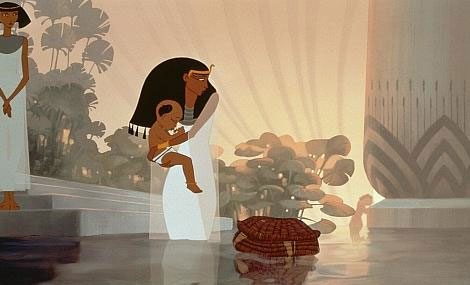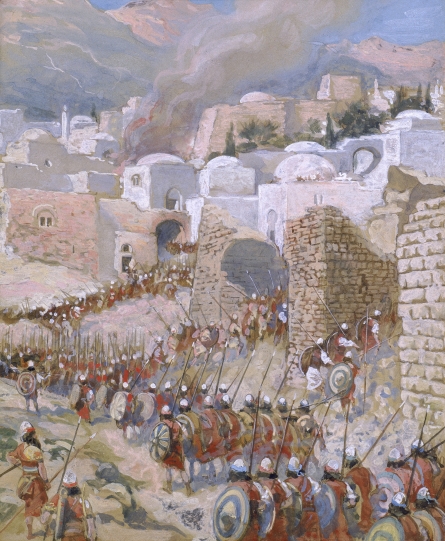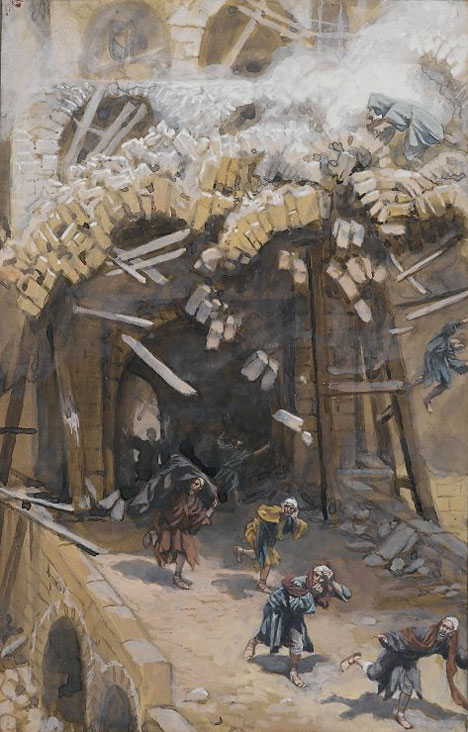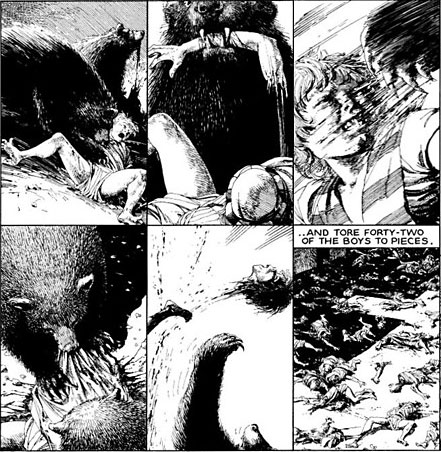Jul
23
2013
 Bible Symbols in Pacific Rim
Bible Symbols in Pacific Rim
“Then I saw another mighty angel coming down from heaven, wrapped in a cloud, with a rainbow over his head, and his face was like the sun, and his legs like pillars of fire. He had a little scroll open in his hand. And he set his right foot on the sea, and his left foot on the land, and called out with a loud voice, like a lion roaring. When he called out, the seven thunders sounded.” (Revelation 10:1-3)
Just a few notes on Pacific Rim, a movie which we enjoyed very much. It’s one of those films where you know your strings are being pulled, but they are doing it so well you don’t mind at all. There are some interesting deviations from the Hollywood formula, and they are worth identifying.
(Oh, and River says there’s spoilers ahead.)
Continue reading
2 comments | tags: Daniel, Postmillennialism, Revelation, Tabernacle | posted in Biblical Theology, The Last Days
Jul
16
2013
 “When Moses slew the Egyptian, he was doing the will of God but not with the power of God.”
“When Moses slew the Egyptian, he was doing the will of God but not with the power of God.”
Numbers 12:3 says that Moses was the meekest man “on the face of the ground [adamah].”
Psalm 37:11 says the meek will inherit the Land [eretz] and delight in abundant prosperity.
Isaiah 11:4 says that
with righteousness [God] shall judge the poor,
and decide with equity for the meek of the Land;
and he shall strike the Land with the rod of his mouth,
and with the breath of his lips she shall kill the wicked.
Firstly, what is meekness? And secondly, why is it connected to “face of the ground” (Adam), or Land?
This post has been slain and resurrected for inclusion in my 2015 book of essays, Inquietude.
Continue reading
Comments Off | tags: Ascension, Firstfruits, Genesis, Herod, Isaiah, James Jordan, Matthew, Moses, Pharaoh, Tabernacle | posted in Bible Matrix, Biblical Theology, Christian Life, Ethics, Quotes, The Last Days
Jul
3
2013
 James B. Jordan was the first Bible teacher I ever heard who had an opinion on the gift of tongues in relation to the rest of the Bible. This gent cops a lot of criticism from the establishment for various things, but he is one who really “gets” the Bible. This is because he asks the right questions. And, without being too harsh, he most often makes all the other theologians and Bible teachers in any debate, on both sides of the debate, look like kindergarten children.
James B. Jordan was the first Bible teacher I ever heard who had an opinion on the gift of tongues in relation to the rest of the Bible. This gent cops a lot of criticism from the establishment for various things, but he is one who really “gets” the Bible. This is because he asks the right questions. And, without being too harsh, he most often makes all the other theologians and Bible teachers in any debate, on both sides of the debate, look like kindergarten children.
Continue reading
1 comment | tags: AD70, Babylon, Corinthians, Luke Welch, Numbers, Systematic typology, Tongues, Trumpets | posted in Biblical Theology, Quotes, The Last Days
Jun
29
2013

The Falling Architecture of Luke 12:49 – 13:35
An online friend noticed that the tower of Siloam in Luke 13:4 killed eighteen people, and only a few paragraphs later, in 13:11, the bent-over woman had been disabled for eighteen years. Is this a coincidence? Not likely.
Continue reading
Comments Off | tags: Chiasm, Covenant Theology, Literary Structure, Luke, Steve Jeffery | posted in Bible Matrix, Biblical Theology, The Last Days
Jun
27
2013

So I find it to be a law that when I want to do right, evil lies close at hand. For I delight in the law of God, in my inner being, but I see in my members another law waging war against the law of my mind and making me captive to the law of sin that dwells in my members. (Romans 7:21-23)
Interpreters debate the meaning of Paul’s words in Romans 7:14-25. Are we to apply these statements to a Christian or a non-Christian? Could a Christian utter these words? Perhaps a better question is, are these the words of an unregenerate man?
Continue reading
Comments Off | tags: Numbers, Paul, Romans | posted in Biblical Theology, Christian Life, Ethics, The Last Days
Jun
24
2013

or Who Is The Real Jericho?
Atheists love to embarrass Christians with a snide reference to the story of Elisha setting two bears upon some helpless children. What nobody, even Christians, seem to get is the “Covenant significance” of all the players in the story, harking back to Moses. The prophets were, after all, God’s “repo men.” [1]
[This post has been refined and included in Sweet Counsel: Essays to Brighten the Eyes.]
Continue reading
Comments Off | tags: AD70, Covenant curse, Covenant Theology, Egypt, Elisha, Feasts, Herod, Jericho, Jezebel, Kings, Leviticus, Peter Leithart, Pharaoh, Revelation | posted in Apologetics, Bible Matrix, Biblical Theology, The Last Days
Jun
4
2013
or Bird’s Eye View
[This post has been refined and included in Sweet Counsel: Essays to Brighten the Eyes.]
Continue reading
2 comments | tags: Genesis, Herod, Noah, Revelation, Systematic typology, Urim and Thummim | posted in Bible Matrix, Biblical Theology, The Last Days
Jun
1
2013

How does Peter see the apocalyptic imagery of Joel in the events of Acts 2?
The first step is to take note of the context of Joel’s prophecy. It is the coming destruction of Jerusalem in 586 BC.
And it shall come to pass that everyone who calls on the name of the Lord shall be saved. For in Mount Zion and in Jerusalem there shall be those who escape, as the Lord has said, and among the survivors shall be those whom the Lord calls. (Joel 2:32)
Even if we identify the context, it may sound to us as if Joel is still looking forward to the first century events at the end of his predictions. The unfortunate chapter break between 2 and 3 stops us reading further, but if we keep reading without a break, the beginning of chapter 3 makes it clear that Joel is still speaking about the restoration from exile. God would judge all the Canaanite nations, including Israel, who had behaved like a Canaanite. But only Israel would resurface from the “flood” of Babylonian control, while all the Canaanite powers remained scattered forever. And Israel would be vindicated across the world, from India to Ethiopia, in the events of the book of Esther (predicted in Ezekiel 38-39).
This means that the particular “day of judgment” had already passed by the time Peter quoted the prophet, so he is not quoting the prophecy to announce its soon fulfillment. He is, however, announcing a similar destruction of Jerusalem and its Temple, with all that this entails.
Continue reading
Comments Off | tags: Acts, Joel, Pentecost, Peter | posted in Biblical Theology, Q&A, The Last Days
May
13
2013
 The letters to the pastors of the seven churches in Asia are a prophecy of the history of the Church, according to dispensationalist Bible teachers. For interpreters who are committed to a “literal” hermeneutic, this is bending the rules in the direction of a “literary” hermeneutic, which is excellent. However, they apply the letters to the wrong future, and overlook the obvious allusions to the past.
The letters to the pastors of the seven churches in Asia are a prophecy of the history of the Church, according to dispensationalist Bible teachers. For interpreters who are committed to a “literal” hermeneutic, this is bending the rules in the direction of a “literary” hermeneutic, which is excellent. However, they apply the letters to the wrong future, and overlook the obvious allusions to the past.
Continue reading
2 comments | tags: Dispensationalism, Lampstand, Literary Structure, Revelation | posted in Bible Matrix, Biblical Theology, The Last Days
 Bible Symbols in Pacific Rim
Bible Symbols in Pacific Rim































